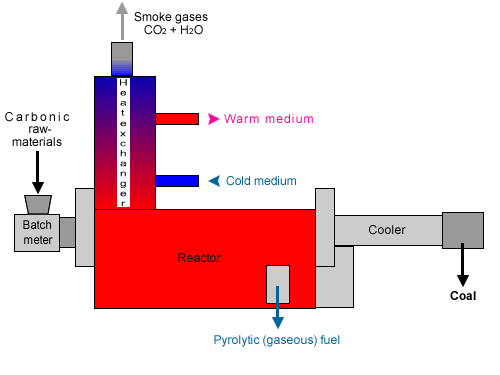|
2. Woody raw-materials
2.1. Mean heating value in common firewood burning down, e.g. birch, is
2 300 kCal/kg.
2.2. Mean volume of pyrolytic gas obtained from 1 kg of woody raw-material (firewood, fillings,
substandard waste products, etc.) at the pyrothermogasogenerator totals 1,2 m3.
2.3. Composition of the pyrolytic gas obtained:
| Composition |
Ratio |
| CnHm |
19...29% |
| CH4 |
33...45% |
| H2 |
12...28% |
| CO |
11...18% |
| CO2 |
1,5...2,5% |
2.4. Specific weight of pyrolytic gas (at 00C and P=760 mm Hg) is
0,65...0,85 kg/m3.
2.5. The lowest heating value of pyrolytic gas at 200C and atmospheric
pressure 760 mm Hg is 8 700...9 500 kCal/m3, i.e. 1 kg of woody raw-material
processed in pyrothermogasogenerator produces at least 10 440 kCal/kg.
2.6. The pyrothermogasogenerator efficiency in pyrolysis of woody raw-materials to gas is 85% on the
average. Thus, 1 kg of woody raw-material processed in this unit provides 8 874 kCal, what is 3,8
times greater than in common burning down of birch firewood.
2.7. The maximum flame temperature in burning down of pyrolytic gas in burners is
2 3000C.
2.8. Composition and main characteristics of the natural gas to be compared:
| Composition |
Ratio |
| CH4 |
94...98% |
| Non-combustible impurities |
2...6% |
Specific weight - 0,73 kg/m3.
Lower heating value - 8 500 kCal/m3.
Maximum flame temperature - 1 8500C.
3. Raw-Material - Coking Pit Coal
3.1. Composition and main characteristics of coke gas produced in pyrothermogasogenerator:
| Composition |
Ratio |
| CnHm |
19...29% |
| CH4 |
25% |
| H2 |
50% |
| CO |
8...10% |
| Non-combustible impurities |
15...17% |
Specific weight - 0,47 kg/m3.
Lower heating value - 4 500 kCal/kg.
Maximum flame temperature - 2 2000C.
|
